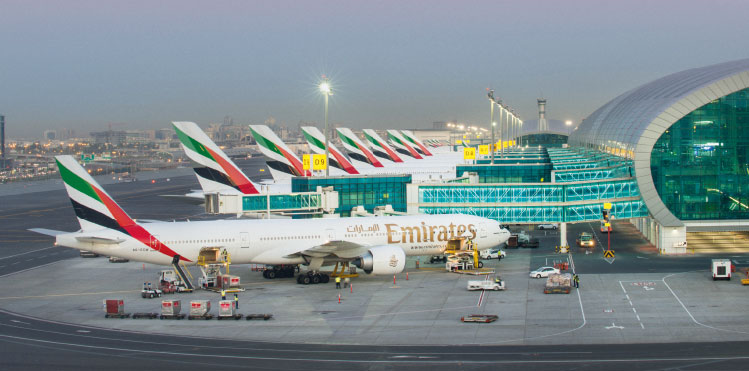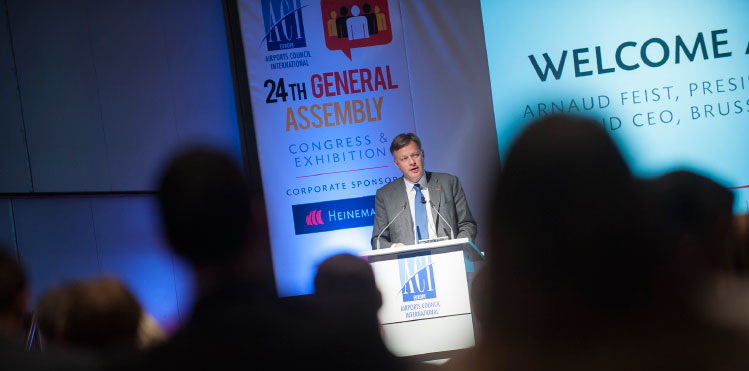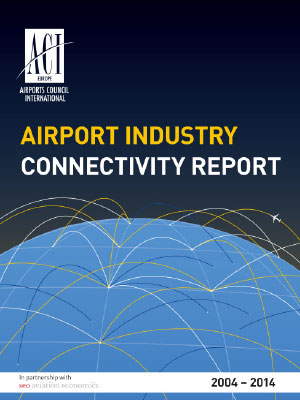
Significantly, the intercontinental connectivity of Dubai Airport alone is equivalent to the combined intercontinental connectivity of London Heathrow, Frankfurt and Paris-Charles de Gaulle.
Connectivity is a word that regularly peppers business conversations in the airport industry, in the context of airport route development conversations and conferences, foreign direct investment in a region and of course social and economic impact. The reason for this is simple, airports live or die by that metric – the level of their connectivity: the diversity and frequency of the flights they offer.
Different metrics have been in use for some time – the most prominent being the number of direct routes an airport offers. However, that metric is unsatisfactory for two reasons – 1. it ignores the importance of frequency of service, but also 2. it ignores the significance of indirect connectivity, offered via services that link to hub airports.
In 2013, ACI EUROPE announced a collaboration with the company SEO Aviation Economics – a specialist consultancy in the Netherlands that had developed a unique methodology (called NetScan) for measuring connectivity, including frequency and indirect connectivity. The collaboration would include a full review of connectivity in Europe over the past decade, and also offer a special customised service, for airports seeking to measure their own connectivity more thoroughly.
On the occasion of the 24th ACI EUROPE Annual Assembly, Congress and Exhibition taking place in Frankfurt, Arnaud Feist, President of ACI EUROPE and CEO of Brussels Airport, announced the release of ACI EUROPE’s Airport Industry Connectivity Report, and outlined the main findings of the first-of-its-kind report. By measuring and analysing airport connectivity through various levels of aggregation and individual airport connectivity figures for the 461 airport-strong membership of ACI EUROPE, the release of the report provides the first ever in-depth review of the way connectivity has performed in Europe over the past 10 years.
Feist commented: “Trade, tourism, foreign investment, increased productivity and competitiveness all tally closely to the connectedness of people and businesses. Given that aviation is a prime and unsurpassed enabler of global connectivity, airport connectivity has profound implications on the way in which economic growth is generated. As such, airport connectivity doesn’t just matter at European level, because it trickles down to national, regional and local levels – shaping the fortunes of our communities as well as the mandate of every airport.”
The report reveals the serious and lasting impact of the 2008/2009 crisis on connectivity – in particular for the EU. Since 2008, the connectivity of EU airports has barely increased, with direct connectivity actually falling by -7% – in sharp contrast to non-EU airports in Europe, in particular in Turkey, which saw direct connectivity increase by +34%.
The report also shows that while EU hubs have been more resilient than small and regional airports in term of direct connectivity, they are now facing significant competition from hubs located in Turkey, the Gulf and to a lesser extent, Russia.
Since 2004, EU hubs have lost 10% of their market share on indirect connections out of Europe. They have fallen behind the Gulf hubs in terms of intercontinental connectivity – ie. connections offered by hub airports between World Regions other than their own. Back in 2004, the level of intercontinental connectivity offered by the top 3 Gulf hubs (Dubai, Abu Dhabi and Doha) was well below that of the top 3 EU hubs (London Heathrow, Frankfurt and Paris-Charles de Gaulle) and could be regarded as marginal.

On the occasion of the 24th ACI EUROPE Annual Assembly, Congress and Exhibition taking place in Frankfurt, Arnaud Feist, President of ACI EUROPE and CEO of Brussels Airport, announced the release of ACI EUROPE’s Airport Industry Connectivity Report, and outlined the main findings of the first-of-its-kind report.
Today, these same top 3 Gulf hubs have established a leading market position, providing twice the level of intercontinental connectivity offered by the top 3 EU hubs. Significantly, the intercontinental connectivity of Dubai Airport alone is equivalent to the combined intercontinental connectivity of London Heathrow, Frankfurt and Paris-Charles de Gaulle.
Feist said “The EU’s decreasing connectivity speaks of slower and less inclusive growth. Our report shows that connectivity cannot be taken for granted, as traffic growth does not necessarily translate into connectivity gains. It also points to Europe being bypassed as an aviation hub and no longer being the significant player in providing global connectivity. These findings are alarming and they should serve as a wake-up call to our governments and the EU institutions.”
ACI EUROPE is pleading for a policy response, through the EU developing its own agenda for aviation connectivity. However, Feist was keen to clarify that he was not talking about a defensive agenda, whereby Europe would limit traffic rights for some airlines – or even use trade instruments for rather distant and hypothetical gains. “I am talking about an affirmative agenda, where the EU and governments would connect the dots and align all aviation related issues around the same objective – using aviation to underpin growth.”
Airport capacity in the equation

ACI EUROPE’s Airport Industry Connectivity Report provides the first ever in-depth review of the way connectivity has performed in Europe over the past 10 years.
This policy agenda for connectivity primarily requires addressing the looming airport capacity crunch. Given the essential role played by hub airports in global connectivity, the prospect of seeing more than 20 major European airportsbecoming fully congested by 2035 should be addressed as a priority – as part of EU and national aviation long-term strategic planning.
It also requires doing away with existing bilateral air services agreements which are acting as an artificial constraint on connectivity. Opening up market access through EU negotiated agreements with our main trading partners (BRICS, ASEAN and MINT) should be a priority.
With a freshly elected European Parliament and a new European Commission taking office in the autumn, Feist considered that the time is right for a new policy direction and then concluded: “Our agenda for connectivity is a compelling case for more Europe. But it is also a case for Europe to work differently. The search for prosperity means that the EU institutions need to work better with business. ACI EUROPE is looking forward to playing its part in addressing this challenge.”
The ACI EUROPE Airport Industry Connectivity Report 2004-2014 is available to download from the Policy Library on the ACI EUROPE website: www.aci-europe.org
To enquire about the Customised Connectivity Report service, visit: www.airport-connectivity.com







